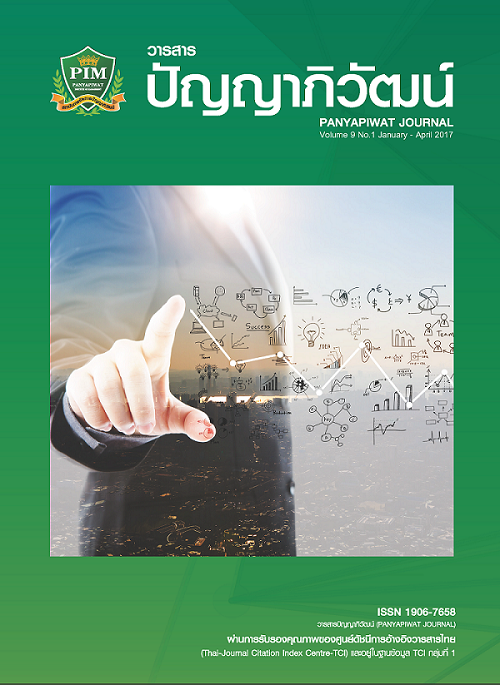การศึกษาเปรียบเทียบระดับความผูกพันของพนักงานตามเกณฑ์ช่วงอายุ กรณีศึกษา กลุ่มบริษัทธุรกิจเฟอร์นิเจอร์ ABC
Main Article Content
บทคัดย่อ
การวิจัยมีวัตถุประสงค์ 1) เปรียบเทียบระดับความผูกพัน 2) ทราบปัจจัยที่ทำให้เกิดความผูกพันของพนักงานแต่ละเจนเนอเรชั่น กลุ่มตัวอย่างเป็นพนักงานของกลุ่มบริษัทธุรกิจเฟอร์นิเจอร์ ABC จำนวน 787 คน เครื่องมือใช้ในการวิจัยคือ ตัวบ่งชี้ความผูกพัน แบบประเมินตัวบ่งชี้ความผูกพันฯ และแบบสำรวจความผูกพันของพนักงาน วิเคราะห์ข้อมูลด้วยความถี่ ร้อยละ ค่าเฉลี่ย ส่วนเบี่ยงเบนมาตรฐาน เปรียบเทียบความแตกต่างของค่าเฉลี่ยปัจจัยสร้างความผูกพัน ระดับความผูกพัน และผลงาน ด้วยสถิติ One Way ANOVA ผลการวิจัย พบว่า ปัจจัยที่สร้างความผูกพันภาพรวมในระดับมาก 3 ปัจจัย คือ ด้านสภาพแวดล้อมขององค์กร (X = 3.93, S.D. = .55) ด้านลักษณะงาน (X = 3.88, S.D. = .49) และด้านบุคคลและสังคมในองค์กร (X = 3.79, S.D. = .59) ตามลำดับ ทั้งสามกลุ่มคือ Baby Boomer, Generation X และ Generation Y มีค่าเฉลี่ยด้านสภาพแวดล้อมขององค์กรสูงสุด ส่วนระดับความผูกพันและด้านผลงานอยู่ในระดับมาก (X= 4.07, S.D. = .48) กลุ่ม Baby Boomer มีค่าเฉลี่ยสูงสุด รองลงมาคือ Generation X และ Generation Y เปรียบเทียบความแตกต่างของปัจจัยสร้างความผูกพัน ระดับความผูกพัน และผลงาน พบว่า ด้านลักษณะงาน ระบบองค์กร และสภาพแวดล้อมขององค์กรของกลุ่ม Baby Boomer มีค่าเฉลี่ยสูงสุด รองลงมาคือ Generation X และ Generation Y ตามลำดับ (p<.05) ส่วนค่าเฉลี่ยระดับความผูกพันของกลุ่ม Baby Boomer สูงกว่าค่าเฉลี่ยของกลุ่ม Generation Y (p<.05) แต่พบว่า ค่าเฉลี่ยด้านผลงานตามเจนเนอเรชั่นไม่แตกต่างกัน
The purposes of this study were 1) to compare engagement score 2) to know engagement factors of staff divided by generation. The samples were 787 participants who worked in ABC company. The research instruments were ABC furniture group employee engagement model, employee engagement model questionnaire and engagement survey questionnaire. Data were analyzed by using frequency, percentage, mean, standard deviation. Compare the difference of employee’s engagement drivers, engagement score and performance by One Way ANOVA statistic. The study found that overall engagement drivers at a high level, three drivers were organization climate (X = 3.93, S.D. = .55), job characteristics (X = 3.88, S.D. = .49), and people/social (X = 3.79, S.D. = .59) respectively and three groups were Baby Boomer, Generation X and Generation Y, mean of an organization climate was highest. The engagement score and performance were high level (X= 4.07, S.D. = .48) that Baby Boomer employee has a highest mean both, followed by Generation X and Generation Y respectively. Compare the difference of engagement drivers, engagement score and performance found that mean of job characteristics and organization climate in baby boomer was the highest, followed by Generation X and Generation Y respectively (p<.05). Mean of engagement score in baby boomer was higher than Generation Y (p<.05). But mean of performance by generation was not significantly different.
Article Details
“ข้าพเจ้าและผู้เขียนร่วม (ถ้ามี) ขอรับรองว่า บทความที่เสนอมานี้ยังไม่เคยได้รับการตีพิมพ์และไม่ได้อยู่ระหว่างกระบวนการพิจารณาลงตีพิมพ์ในวารสารหรือแหล่งเผยแพร่อื่นใด ข้าพเจ้าและผู้เขียนร่วมยอมรับหลักเกณฑ์การพิจารณาต้นฉบับ ทั้งยินยอมให้กองบรรณาธิการมีสิทธิ์พิจารณาและตรวจแก้ต้นฉบับได้ตามที่เห็นสมควร พร้อมนี้ขอมอบลิขสิทธิ์บทความที่ได้รับการตีพิมพ์ให้แก่สถาบันการจัดการปัญญาภิวัฒน์หากมีการฟ้องร้องเรื่องการละเมิดลิขสิทธิ์เกี่ยวกับภาพ กราฟ ข้อความส่วนใดส่วนหนึ่งและ/หรือข้อคิดเห็นที่ปรากฏในบทความข้าพเจ้าและผู้เขียนร่วมยินยอมรับผิดชอบแต่เพียงฝ่ายเดียว”
เอกสารอ้างอิง
Arsasongtham, J. (2012). Persuasion the Gen Y to work with happiness in organization. Executive Journal Bangkok University,32(2), 202-208. [in Thai]
Cook, S. (2008). The Essential Guide to Employee Engagement Better Business Performance through Staff Satisfaction. London and Philadelphia: Kogan Page.
Chearbangkaew, P. (2011). Diversity Management: Human Resource Management Strategy in the Creative Economy. Executive Journal Bangkok University,31(1), 153-159. [in Thai]
Dechawattanapaisan, D., Numpraya, K., Nualluk, J. & Pluemboon, C. (2014). A study of viewpoints and expectations of generational characteristics between generation X and generation Y. Chulalongkorn business review, 36(141), 1-17. [in Thai]
Kengkarnchang, K. (2013). Generation Y and a New Challenge in a Human Resources Administration. Journal of Social Science and Liberal Arts,2(1), 15-27. [in Thai]
Khambunrat, W. (2015). Generation management in organizations of the marketing 3.0 era. Executive Journal Bangkok University, 35(2), 3-10. [in Thai]
Kittimanont, H. (2014). A causal model of health professional personnel performances in the university hospitals in Thailand. Doctor of philosophy program in Public Health (Hospital Management), Christian University. [in Thai]
Leelathanapipat, J. & Pasunon, P. (2016). Factors affecting organizational commitment of support staff case study: private higher education institution. Panyapiwat Journal, 8(special issue), 145-155. [in Thai]
Limweeraphan, S. (2007). Employee Engagement: a case study of rayong purifier PLC. Master of Science, National Institute of Development Administration. [in Thai]
Manakit, N. (2011). Organization engagement of 3 generations working group: a case study of the primary school teachers working under of Nakhonpathom provincial primary education, region 1. Master of business administration, Kasetsart University. [in Thai]
Suthammanon, L. & Osathanugrah, K. (2015). Employee engagement model: a case study of bill payment service business XYZ company limited. Panyapiwat Journal, 7(2), 96-107. [in Thai]
Tantayapinun, S. (2011). Management Tactics for a Diverse Workforce. Executive Journal Bangkok University, 31(4), 59-64. [in Thai]
Tilakon, C. (2012). Personality study of employees of the generation Y group affecting job characteristics: a case study of the private company. Independent study master of business administration, University of the Thai Chamber of Commerce. [in Thai]
Wilson, B., Squires, M., Widger, K., Cranley, L. & Tourangeau, A. (2008). Job satisfaction among a multigenerational nursing workforce. Journal of Nursing Management, 16(6), 716-723.
Yusabai, R. (2013). Development of learning dynamic group model for promoting diabetes mellitus patient’s health behaviors. Doctor of philosophy program in Technology Educational Department, Faculty of Technical Education, King Mongkut’s University of Technology North Bangkok. [in Thai]


